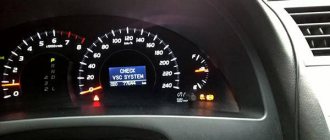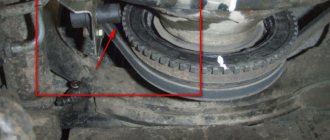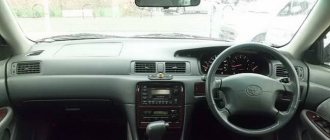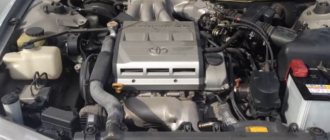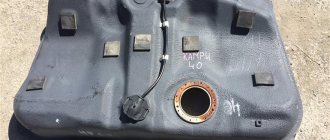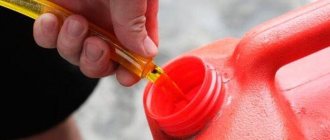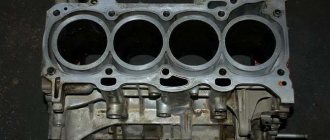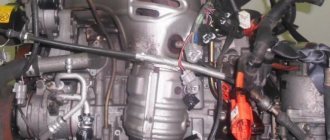Camry of any generation is a reliable car. But time and the careless attitude of the owners do not pass without a trace. Therefore, even the Camry may not start. If your Camry won't start, there could be several reasons.
Engine V6 3.0 1MZ
Toyota Camry won't start, starter turns
To make it clearer what we are going to talk about, I found a picture on the Internet - photo 1.
So, Toyota Camry 2007, gasoline. The car was brought on a tow truck: “It won’t start.” The client said that he brought the car from another car service center, the car diagnostics there said that “their scanner does not communicate with and does not support this car, so sorry.” The client had previously tried to start the engine on his own, but it didn’t work, and the battery ended up being completely discharged.
After charging the battery (should I always start with this?), I walked up and looked at the instrument panel: “What’s lit on the panel? What kind of light bulbs? What doesn’t burn?” And I didn’t see the familiar CHECK ENGINE icon. I even tapped my finger lightly, no, it doesn’t light up (variants of this icon) :
The situation is both unpleasant and familiar, here is an approximate list of reasons why the CHECK ENGINE light may not light up: 1. It is sealed with electrical tape 2. It is specially unscrewed 3. A “cunning” circuit has been installed that turns on the light AFTER TURNING ON THE IGNITION AND TURN IT OFF after the engine starts - but the circuit stopped working 4. All sorts of homemade “secrets” 5. Malfunction of the car’s electrical circuits 6. The engine control unit is faulty
Version No. 6 is the most unpleasant, but it would be stupid to start troubleshooting with it. Troubleshooting should always start with what is closest - logically and at arm's length, as in this case.
I connected TOYOTA TECHSTREAM and made sure that it also did not communicate with the control unit. Well, now it seems clear why the previous fellow automotive diagnosticians did not want to “dig deeper” into this car: this is a “real pain in the ass” and it’s not immediately clear how much work will have to be done and what kind of money can be earned here.
We need to check the food. I open the MotorData program: https://motordata.ru/ru and I’ll immediately tell you why. In my opinion, this is the most convenient program at the moment for finding such faults. It allows you to quickly move from section to section, to schematic diagrams, fuse locations, and so on... no need to flip through dozens or hundreds of pages of manuals - there is a convenient, quick search and navigation: click on an element and you can immediately see where it is located, click again - and here is the pinout of the control unit.
I look at the pinout of the control unit and the circuit. This is me already in Motordat - photo 1 .
I determine where and what potentials are, pluses, minuses, and I see that there is no main power supply to the engine control unit, where two thick red wires go, connectors 1B and 2B - there is no “plus” there when the ignition is turned on.
Next, using the same Motordata, all fuses and connection points were successfully checked - and after that I smoothly moved to the mounting block located under the engine hood. At the moment we are interested in the engine control system relay; in the diagram and photo 2 is designated as K37.
This relay supplies power to the engine control unit. If it is faulty or the “plus” supply to this relay or the “plus” switching does not work, then the control unit will not start completely and the CHECK ENGINE light on the instrument panel will not light up. Shall we go further?
This relay is integrated into the mounting block, photo 3,
which is very inconvenient - on older cars the relay is not integrated and can be removed, inspected or even replaced if necessary. Here the relay is hard-soldered, filled with compound, express checks of the relay are not relevant...
We have to start with the simplest thing: using the Motordata program, we find a fuse that supplies power to this relay. The fuse is OK. We look at the signal supply to the relay when the ignition is turned on and look at the “plus” output from the relay... checking the signal pulses... control signals... the relay arrives, the relay is triggered, the contacts click, but on the connector that connects the “plus” relay to the control unit, “plus” " absent. The relay clicks, but there is no “plus”.
I would like to mention the so-called “reverse memory” in humans. And for a car diagnostician it develops greatly. What is it (in my opinion): this is when you do something, look, go further through the check points and at some point something matches and you get a “reverse memory effect” - the same here. At that moment, I somehow especially vividly remembered that when I had to partially disassemble the mounting block, I noticed that some part of the mounting block was wet, in some electrical connectors the water was simply “standing” in droplets.
I asked the client what it was and what it could be causing. And he himself was surprised. I couldn't remember anything. Well, in my opinion, there is either a lot of washing with the help of Karcher or active forcing of the water barrier. Why: the cover of the mounting block itself was tightly latched, neither snow, nor rain or anything like that could just get in from the street. Unbelievable but true.
In photo 4 you can see traces of water getting into the mounting block.
Part of the mounting block has been dismantled, together with my assistant Anton we carry out a very careful inspection: are there any oxides, greening... no, everything is clean, alive, the compound is light, there is no “greening” or oxidation. But I can’t say the same about the connectors, photos 5,6,7,8:
It took a lot of effort. Cleaning rust from contacts is a lot of work! The mating part of the “mother” turned out to be very rotten, so we had to take the “mother” from the side and put it here. Seal everything securely so that this can’t happen again.
What happened as a result: everything turned out great! .. -))
After the resuscitation of the mounting block, contacts and other things was carried out, power went to the control unit, the “check” light on the instrument panel lit up as it should, the whole system began to function normally, that is, “normally”. Everyone was satisfied, both me, my assistant Anton and the client. Well, it’s understandable - he was happier than everyone else...-)
Kudryavtsev M.E © Legion-Avtodata
Camry 40 won't start
Toyota Camry 40 are reliable cars in harsh Russian operating conditions. Like all cars with a service life of more than five years, there are situations where the engine fails to start before starting a trip.
The reasons for the failure may be different; depending on the specific malfunction, appropriate measures must be taken to eliminate it.
Symptoms of Engine Start Failure
Depending on the operating conditions of the vehicle and the specific situation, the following options for failure to start the Camry 40 engine are possible:
The engine does not start after a long period of parking. The starter does not rotate or rotates very poorly. First of all, you should check the voltage at the battery terminals. During long-term parking, some electronic devices continue to operate:
- standard and non-standard car alarms;
- a device that supports car radio memory;
- some components of the body control unit.
Battery leakage current for Toyota Camry v40 2.4, 167hp. when parked it is approximately 20 - 50 milliamps. The leakage current can be increased to 100 mA. In this case, the current consumption per day will be almost 2.5 Ampere*hour. In 20 days, the battery will be discharged by 50 Amp-hours. In the case of a low battery, its voltage may be less than 12.0 Volts, which may not be enough for normal starting. To determine the voltage on the battery, you need to measure it with a multimeter.
If the voltage at the battery terminals is less than 11.8 Volts, it should be charged.
The engine does not start after being parked overnight. At night, especially in the cold season, the car is “filled” with moisture due to condensation processes. Corrosion processes are intensifying. The most problematic place in the Toyota Camry 40 is the connection of the negative terminal of the battery to the car body. Before the start of the cold season of car operation, it is necessary to clean and tighten this place, as well as the battery terminals. Failure to start after overnight parking may be due to extremely low residual battery capacity. In this case, the battery must be replaced.
A possible cause could be a faulty generator. In this case, the battery charging indicator lamp should light up on the dashboard.
In cold weather, difficult rotation of the starter may be due to the wrong choice of car oil.
The engine will not start on a well-charged battery. The starter doesn't turn over. Possible reasons:
- starter failure;
- malfunction of the starter control relay;
- malfunction of the vehicle's electrical equipment;
- failure of the ignition switch contact group;
- blown individual fuses.
To fix the problem, you need to check the starter, fuses, and relays.
Low battery
Battery device
After the car has been idle for a long time, problems arise with starting the engine. The reason for this phenomenon is a discharged Camry battery. Due to infrequent use, the battery loses its charge as some devices continue to work. After all, even in the garage, motorists prefer to leave the alarm system and devices responsible for storing electronic options working.
When your Camry won't start, the first thing you should do is check the working condition of the battery. For these purposes, a multimeter is used - a device that will help measure battery voltage. Normal readings should be at least 12.0 Volts. But if the car has been sitting for a week, then due to current losses this figure decreases.
Operating conditions stipulate that if the Toyota Camry battery voltage is less than 11.7, then there may be problems starting the engine. At such indicators, it is recommended to recharge the battery.
If the Toyota has been parked for one night in cold weather, then it would be a good idea to check the terminals for oxidation and clean them if necessary. The ground wire requires close attention.
Positive battery terminal
When preparing the car for the winter, you need to check the condition of the wiring and connections, since this affects the smooth operation of many parts and components.
But sometimes recharging the battery does not help and the voltage is not enough to start the engine after several hours. When the internal combustion engine is running, the battery receives current from the generator for the full functioning of the electronics. But this device also has its own margin of “strength”. For incorrect operation of the generator - the cause of undercharging of the battery - a minor breakdown is enough.
Types of batteries by terminal location
If the Camry modification does not have an on-board computer that signals problems with this device, then you will have to visit a service center to check it. It is impossible to leave the current generator faulty, since in the future it can provoke more serious breakdowns.
Why Toyota Camry won't start
Any car, including the Toyota Camry, from time to time provides the owner with the opportunity to experience a feeling of excitement as a result of a spontaneous malfunction that leads to the inability to start the engine. Unfortunately, according to reviews from car owners, such moments happen most often in Camry v 30 and 40.
Influence of temperature conditions
Technical documentation regarding the solution to this issue provides for the division of probable malfunctions based on the principle of the temperature state of the engine. Let's try to understand why the car does not start in cold weather or in hot summer.
In conditions where more than six hours have passed since the Camry v 30 engine stopped running (and it’s +20 outside) or more than three hours (at minus 20 degrees), then the methods for starting the engine are identical.
First of all, you need to make sure that all technical fluids in the Camry v 30 are poured into the appropriate spaces, taking into account the requirements of the operational documentation.
To do this, lift the hood and check:
- engine oil level;
- braking and cooling systems;
If an insufficient quantity is detected, it is topped up.
Carry out an external inspection of the Camry v 30 for leaks under the car and the appearance of puddles. It is necessary to check the tightness of the connection of wires to the battery, power armor-piercing wires, modules to spark plugs.
Starting the engine correctly
The next step should be to try to start the Camry v 30 engine with the hood open (if there is no precipitation), calmly carrying out the sequence of actions associated with turning the key to position one (fuel pump power) and then starting the engine. The car should start.
It is necessary to warm up a running car with the hood closed, after first re-inspecting possible leakage areas.
When the engine is warm, the Camry v 40 is started without using the fuel pedal, allowing the control system to independently make comfortable dosing and ignition adjustments.
In case of repeated and unsuccessful attempts to start, when the spark plugs are filled, it is recommended to “blow out” the cylinders by pressing the gas pedal all the way. The fuel system will stop supplying and the excess gasoline will be purged with air. Try again as usual.
If in this case the startup is not carried out, there remain possible causes in the following systems that require diagnostics of the Camry v 40:
- starting system;
- ignition systems;
- fuel supply.
Causes of starter malfunction
A malfunction of the Camry v 40 starting system manifests itself in improper operation or complete inactivity of the car starter, which are expressed in the following:
- Violation of contact connections, shorting of wires or their rupture leads to the fact that the starter does not turn, it does not respond to turning on at all.
- Clicks that sound repeatedly indicate a malfunction in the coil of the solenoid relay, as well as a critical balance of the battery charging current or weak connection contacts in the circuit.
- The starter turns, but does not develop the necessary speed to start or does not rotate at all. This, as a rule, indicates a weak battery, burnt contacts, brushes out of working order, short circuit or broken wiring.
- The starter armature rotates when turned on, but the flywheel is stationary. The clutch housing may be loose or the flywheel may be damaged.
- Doesn't turn off after starting. If this problem occurs, the engine is immediately turned off.
Other non-working Camry v 40 systems are determined by carrying out simple but quite important tests related, first of all, to checking the integrity of fuses located both under the hood and inside the car, disconnecting and connecting high-voltage wires, and checking the tightness of the connectors etc.
All these activities require minimal training in auto mechanics and electrical engineering.
Trust the experts
Important! If a Toyota Camry car does not start, then carrying out repairs yourself without involving specialists of the appropriate profile can lead to fatal consequences for the vehicle systems involved and may require more significant costs than simply contacting a service workshop.
Trust the experts
Important! If a Toyota Camry car does not start, then carrying out repairs yourself without involving specialists of the appropriate profile can lead to fatal consequences for the vehicle systems involved and may require more significant costs than simply contacting a service workshop.
what immobilizer is installed? I had a Black Bug - the most blatant shit. When the battery is low, it does not produce any signals, the car simply does not start. I killed this immobilizer and installed Pandect - what a thing!!!
Right now they did a diagnostic, they said the fuel pump relay is not working! Where is it located? Under the hood in the block or in the cabin? And in general, does anyone have the location of the switches and which one is responsible for what, I looked all over and couldn’t find anything worthwhile!
Or is it the signaling that blocked it along with the fuel pump? Because I don’t hear it when I turn the key. PS: Sher-Than Magicar 8 signaling! For 3 years, the signaling system has simply not been able to compose its brains. If this is the problem, where should I go?
Toyota Camry 2.0 4 doors. sedan, 150 hp, 6 automatic transmission, 2014 – 2021 - The engine will not start
The engine does not start - reasons, troubleshooting
Common reasons why a car engine does not start
The reasons can be both general and specific. It is hardly possible to consider all the options in one article, so we will talk about the most common problems.
First place, perhaps, can safely be given to problems with the battery. Very often the engine does not start as a result of the battery being discharged. It is not necessary that the charge be completely absent. In many cars, the starter refuses to turn if the battery produces less than 10 volts. Taking into account this information, it becomes clear that you should not forget to recharge the battery on time. However, complete failure or problems with starting the engine are not always associated with a low battery charge level. Quite often, oxidized or poorly secured terminals are to blame. From time to time you need to clean them with sandpaper to remove the deposit of oxide film, which is a poor conductor of electricity. The same applies to the contacts on the battery itself. After cleaning, it is recommended to lubricate the terminals with machine oil or lithol so that they do not oxidize. Better yet, replace the copper terminals and install brass ones.
In second place in terms of frequency is a very simple and harmless reason - lack of fuel. There are two options: it may not be in the tank, or it may not enter the engine. The driver's actions in this case are extremely simple. First, check the tank (the sensor may fail or show incorrect values). Secondly, check the fuel line. Perhaps there was a leak somewhere and it filled with air. The complexity and cost of repairs depends on the nature of the damage. Sometimes it is enough to simply replace the hose under the hood.
Fuel may not enter the combustion chamber due to a clogged carburetor or injectors on injection engines. In addition, it happens that the fuel pump fails. The reasons for this can be different, but the most common one is overheating of the fuel pump. Of course, we are talking about those cars in which the pump is installed under the hood (usually carburetor cars). It overheats especially often in the summer heat. Another option, although very rare, is that gasoline has lost its properties (evaporated, diluted with condensate, etc.). This happens if the car has been sitting for more than a year. In this case, it is enough to add fresh fuel or drain the remaining fuel, and then refuel with suitable fuel.
Problems in the ignition system
No spark at the spark plugs or wet spark plugs. This is also a very common reason why the engine will not start. You can check the spark plugs yourself. To do this, you need to have a spark plug wrench in the trunk. Checking for a spark is also not difficult. To do this, you need to unscrew the spark plug, put a contact wire on it and try to turn the ignition key at the moment when the spark plug itself is near the metal. A good spark should be fat and bright. If the spark is weak or absent at all, you should take a closer look at the spark plug contacts. Perhaps they are covered with soot. In this case, they must be cleaned with sandpaper or a wire brush. If this does not help, then you should try replacing the spark plug.
It happens that the spark plug is fine, but there is still no spark. Here you need to check the armored wires and even the ignition coil. By the way, the capacitor on the ignition coil may fail. It is advisable to have a spare one with you (it costs pennies).
There is no spark on the center wire. You can check this way: disconnect the central wire from the distributor cover and unscrew the tip. After this, you need to turn the key and keep the end of the wire near the metal. There must be a good spark. Problem with the ignition switch. It happens that some terminal falls off in the lock itself. Especially on older cars. Naturally, you need to know where to put it again. In addition, fuses may blow. Therefore, it is always worth having a set of spare ones in your car. It is inexpensive, does not take up space, and a blown fuse can not only be the reason why, for example, turns do not work. It’s worse when the internal combustion engine does not start for this reason.
Other possible faults
Problems with the starter solenoid (traction) relay. The most common problem here is burnt nickels (can only be seen when the device is disassembled). In addition, contacts may become unsoldered from them. In this case, when you turn the ignition key, only a quiet click of the starter relay will be heard, and the retractor will be silent. If it is working, it will make a clear metallic click. It is unlikely that it will be possible to repair it on the road. Although the repair is inexpensive and relatively simple.
Problems with the fuel system
Even the most “vigorous” battery and a new, working starter will not be able to start the car if problems arise with the supply of fuel to the cylinders. For this reason, the next thing to check is the engine power supply system.
1.Fuel pump
For carburetor and diesel engines, this unit is located directly next to the cylinder head or block. Injection power plants are equipped with an electric pump, which is installed in the fuel tank. Their operation is judged by a short buzzing sound that appears after the ignition is turned on. As for fuel pumps in carburetor engines, they are mechanically driven by a cam mounted on the camshaft.
It is easy to check the functionality of the fuel pump - to do this, remove the hose from the carburetor inlet fitting and lower it into a suitable container. After this, you should pump up the fuel using the manual pumping lever or by turning on the starter. If the result is negative, check the passage of gasoline through the fuel line and clean the mesh located in the top cover of the pump. If this does not help, then inspect the membrane and valves of the fuel pump. After replacing damaged and worn parts, the functionality of the device will be restored.
2.Fuel filters
Along the path of fuel passing from the tank to the engine there are several filter units - coarse meshes located on the fuel receiver, in the fuel pump and carburetor, and in addition, paper filters located in the section of the fuel line. The intensity and even the possibility of supplying fuel to the internal combustion engine depends on their purity. If you find a blockage, clean or replace the filter elements.
Throttle and injectors
Gasoline internal combustion engines operate on a fuel mixture, which is prepared in the carburetor or in the intake manifold (for fuel-injected cars). In the first case, the fuel passes through a whole system of channels, jets and nozzles that are located in the carburetor. In the second, it is supplied by injectors according to signals received from the electronic engine control unit (ECU).
The air supply is metered using a throttle valve, which, depending on the engine design, can be mechanically or electrically driven. Clean the parts of this assembly and the throttle itself. Also check if fuel is being supplied to the cylinders. If you are dealing with an injection car, then press the fitting spool located at the bottom of the fuel rail - gasoline should flow out from there under pressure. If the stream is too weak, then check the filters, fuel line and pressure reducing valve of the fuel pump.
In carburetor engines, the fuel supply can be judged by sharply opening the throttle - in this case, a portion of fuel will be injected from the accelerator pump nozzle into the diffuser. In addition, for gasoline power units, inspect the spark plugs - they should not be dry. Otherwise, check for the presence of a control signal at the injectors. If everything is in order with this, then you should unscrew the ramp fastening and move it away from the manifold in order to inspect the spray nozzles when starting the engine. The absence of fuel streams or their weak intensity indicates the need to clean or replace the injectors.
As for diesel engines, fuel is supplied to them under high pressure, and a much more complex pump (fuel injection pump) and specially designed injectors are responsible for this. To repair these components, special equipment is required, so in this case it is better to contact specialists.
Something else useful for you:
Topic: Camry V 50 won't start
Theme Options
- print version
- Send by email...
Display
Linear view
- Combined view
- Tree view
Camry V 50 won't start
Camry won't start. After 4 days of inactivity, I could not start the Camry. At first it almost started, but after I released the key the car stalled. Then the starter turns, but the car is amazing. I removed the brand for 20 minutes - it didn’t help. I brought a second set of keys, with a new battery - it didn’t help. I tried to start it with the gas pedal pressed, it grabbed it a couple of times. The starter turns vigorously, the gas tank is full.
Mileage 110 thousand. All maintenance during (all new filters: gasoline, etc.) Improvement of the standard alarm system in Soundspeed
Thank you all in advance for your advice.
Hello. What was it?
I don’t even remember anymore. I called them today, but they are not working.
Turn out any candle and smell it - does it smell like live gasoline or not? You can also smell what the exhaust pipe smells like after turning the starter.
Thank you. I’ll do this, do you recommend anything else?
Depending on the results obtained. It is not possible to describe all possible ways to solve a problem because their number will grow exponentially. Only step-by-step diagnostics if you want to look for the cause yourself.
If the spark plugs in gasoline are wet, it means there is no spark - the power cable to them has been cut. If there is no gasoline on the spark plugs and there is no smell of it coming from the cylinders after cranking, then the injectors do not work in the same way. It is premature to consider mechanical reasons.
You do not write anything about the additional non-standard alarms available on the car. They are often the reason for non-production.
Last edited by SCAR; 01/03/2018 at 15:34 .
THE CAR STARTED. I went to see if the spark plugs are dry or not. Before unscrewing the spark plugs I decided to try starting it again.
I cranked the starter and there was silence. I turned the starters with the gas pedal pressed - it grabbed a little. I turned it again with the pedal pressed - silence, and a very strong smell of gasoline appeared.
I decided that I had nothing to lose and began to turn it with the gas pedal pressed and . oh miracle. The car started up and slowly began to gain momentum. I let it run for 20-25 minutes, then drove it with different modes - acceleration, brake, constant gas, everything was fine. Only - on the scale that shows the average consumption, the needle is at a maximum value of 30, but is slowly dropping down - now it’s somewhere around 25. What happened. I still don’t understand. 1. Tomorrow I’ll change the spark plugs - mileage is 110 thousand. I haven’t changed the spark plugs 2. I’ll go to Soundspeed to diagnose the alarm system. SCAR - special thanks for your support. The incident was not pleasant; we regularly go on vacation by car, and I would not want this to happen again.
Toyota Camry won't start. Causes.
Camry belongs to the class of reliable cars that fail only due to the careless attitude of the owners. This model may not start due to operation in harsh climatic conditions or malfunctions of the main components. Let's consider the question: what to do if the car does not start.
When car enthusiasts hear about problems starting a Camry, they give
one piece of advice - check the battery. This is worth doing before you start looking for other possible causes.
Low battery
It may discharge while the car is standing for a long time without moving or with the alarm working. It is best to park the car for a long time without a battery. You can check the battery charge level yourself; for this you will need a special device - a multimeter.
Normally, the battery voltage should be 12 V; if it drops to 11.7, then you may have problems starting. You will notice them already in the first frost. In this case, you need to charge the battery, especially if you want to start a very cold engine. If your charge level drops over and over again, then you should replace the battery, it could wear out (this happens 3-4 years after you start using a new battery).
If it’s cold outside, then you should start the morning before starting by checking the terminals. They oxidize quickly, especially the one that goes to the mass. You can clean them yourself and try to start the car again. Pay attention to the winding, it should not be broken. In winter, damage to the sheath can lead to problems with starting, so as not to solve them at the first frost, many people lay new wires in the fall. Removing the terminals and then installing them helps no less often. This manipulation allows you to “Reboot” the power supply system.
If you have recharged the battery, but after a few hours you cannot start the car, then the problem may be hidden in the alternator. You can replace it yourself or at a service station. You can understand whether the problem is really in the generator by reading the message from the on-board computer. If your Camry does not have a BC (for example, on the Prominent model), then contact a service station to check the generator so as not to waste money on replacing a working unit. In this case, diagnostics and repairs can be carried out literally in a day.
The starter doesn't turn over
This malfunction is clear from the first attempt to start the car - the ignition system responds only with clicks. The reason for this may be:
- broken wiring or poor contact in it;
- traction relay failure;
- discharged battery;
- lack of contact at the starter terminals;
- short circuit.
If clicking sounds occur, check the starter, relays and fuses. If the reason is in the starter and it works, then it doesn’t - you need to replace this device. Otherwise, you may simply not start the car again. Also pay attention to the mode; you cannot set it to “Drive” (the starter will not spin in it).
A less common reason for
the ignition is a broken lock. Of course, you can try, like in the movies, to start your car using wires, but it is best to go to a service station and have this unit repaired. bring the car to the service using a tow truck.
It was not possible to start the Toyota Camry, but the starter turns
The cause of this type of failure may be a relay or fuses. A common problem with the Camry 40 is a wiring fault - so it’s worth looking under the hood and using a multimeter to check the wires leading to the fuse box.
Inspect the appearance of the wires. You have two ways to fix wiring problems yourself.
- If the wires are oxidized, they need to be cleaned. This will literally take a minute.
- If there is no external damage, it is worth replacing the wiring completely or partially. Then inspect the fuses, if they are faulty, replace them. After this, try starting the car again.
Results
So, the main reasons why a car refuses to start:
- Dead battery.
- Faulty electrical wiring.
- Problems with the starter.
- Problems in the fuel system.
- Alarm malfunction.
Many of the described reasons can be eliminated on the spot. But sometimes you can’t do without the help of specialists.
We recommend monitoring the proper operation of all systems and components of the car, as well as undergoing maintenance according to the recommended schedule of the car manufacturer.
What if the engine doesn't start?
Surely some drivers have encountered such a problem when the engine on a Toyota Camry does not start. What to do in such situations, besides a tow truck? What possible reasons could there be? Let's take a closer look.
The engine does not start when the starter is working normally
The following are possible reasons:
- Low fuel level in the gas tank.
- There may have been an overflow of gasoline in the engine.
- Malfunction in the automatic engine blocking system.
Starter cranks slowly
In this case, the indoor appliances and lighting are dim. the signal sounds quiet or does not sound at all. This may be due to one of the following reasons:
- The battery is low.
- There is no contact at the battery terminals.
The starter does not turn over - option one
This applies more to cars that have an intelligent keyless entry system. The engine starting system may not work due to electrical problems - open circuit, blown fuse. However, not everything is so bad; you can use the emergency start method.
- Put the car on the handbrake.
- The gear shift lever must be in the “P” position. If it is impossible to move the lever in normal mode, read below.
- Turn the ENGINE START STOP switch to ACCESSORY mode.
- Press and hold the “ENGINE START STOP” switch for 15 seconds and at the same time press the brake pedal firmly.
If you manage to start the engine in this way, the system itself may not work properly. So after such cases, it is worth visiting the dealership.
The starter does not turn - option two
In this case, the interior lighting and instruments do not turn on, and the sound signal does not work. This can be caused by several reasons:
- One or both battery terminals are disconnected.
- The battery is completely discharged.
- There is a malfunction in the steering column locking system (vehicles with an intelligent keyless entry system).
If the shift lever cannot be moved when the brake pedal is pressed, there is most likely a problem with the shift stop system. The following measures can be used as an emergency measure to ensure that the shift lever can be moved:
What's happened?
Symptoms of malfunctions and first steps
Your 2021 Toyota Camry V70 starter won't turn over.
You turn the ignition key or press the “Start” button, but there is silence in response. If at this moment your dashboard and lights go out, then most likely the battery is dead. If not, the problem lies in the electrical
Your Toyota Camry V70 2021 Starter turns but won't start.
This often happens if the blocking from the alarm or Immobilizer is triggered. First, you should check the battery charge in the key fob or Tag. If it doesn’t help, the lock is out of order, or there are problems with the engine control system
Toyota Camry V70 2021 engine stalled while driving
In such a situation, the cause of the malfunction is usually the mechanical part of the timing belt, the fuel system or sensors in the electronic systems of the engine, but just in case, do not forget to check the fuel in the tank. The level sensor may have broken
